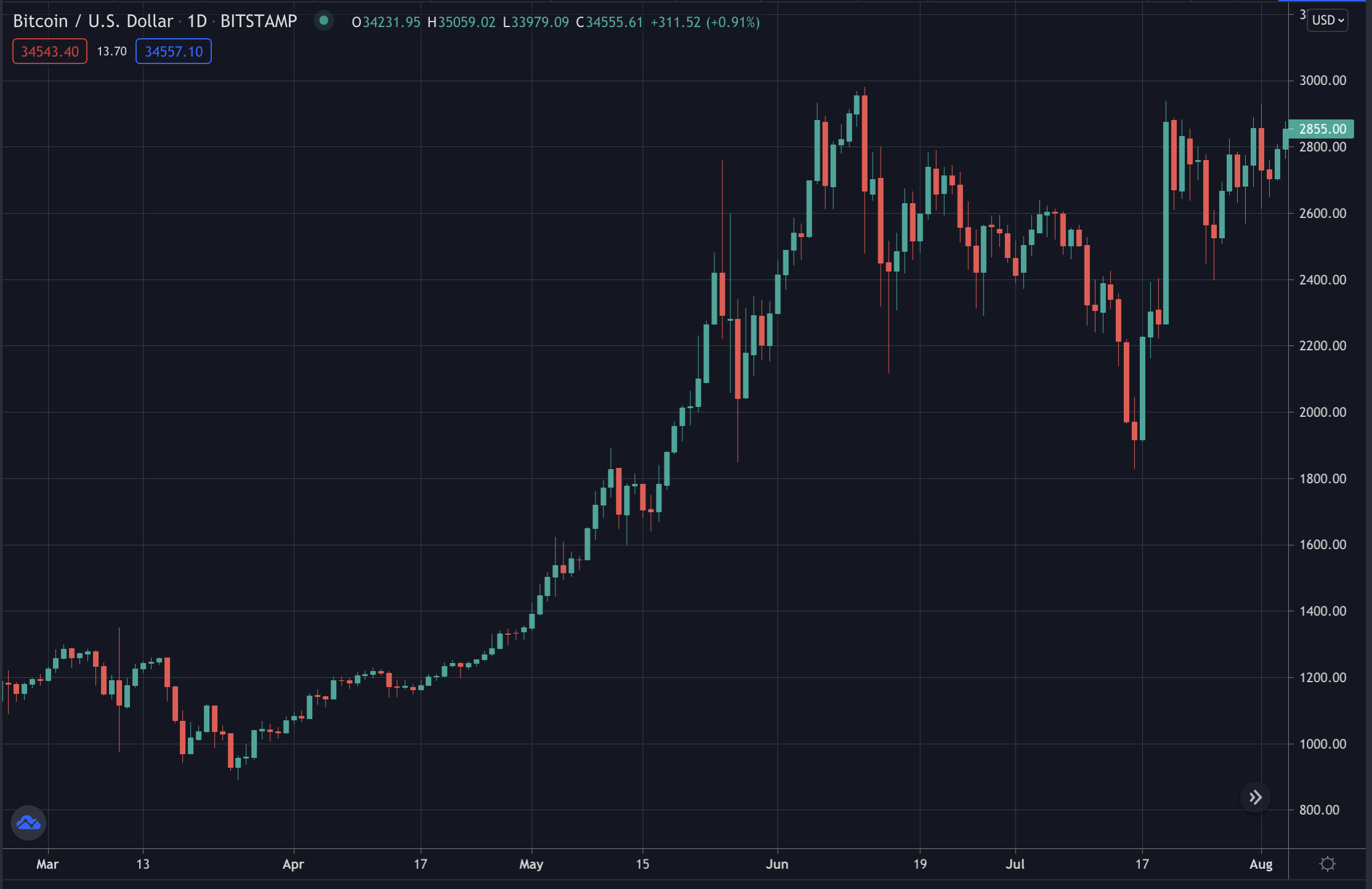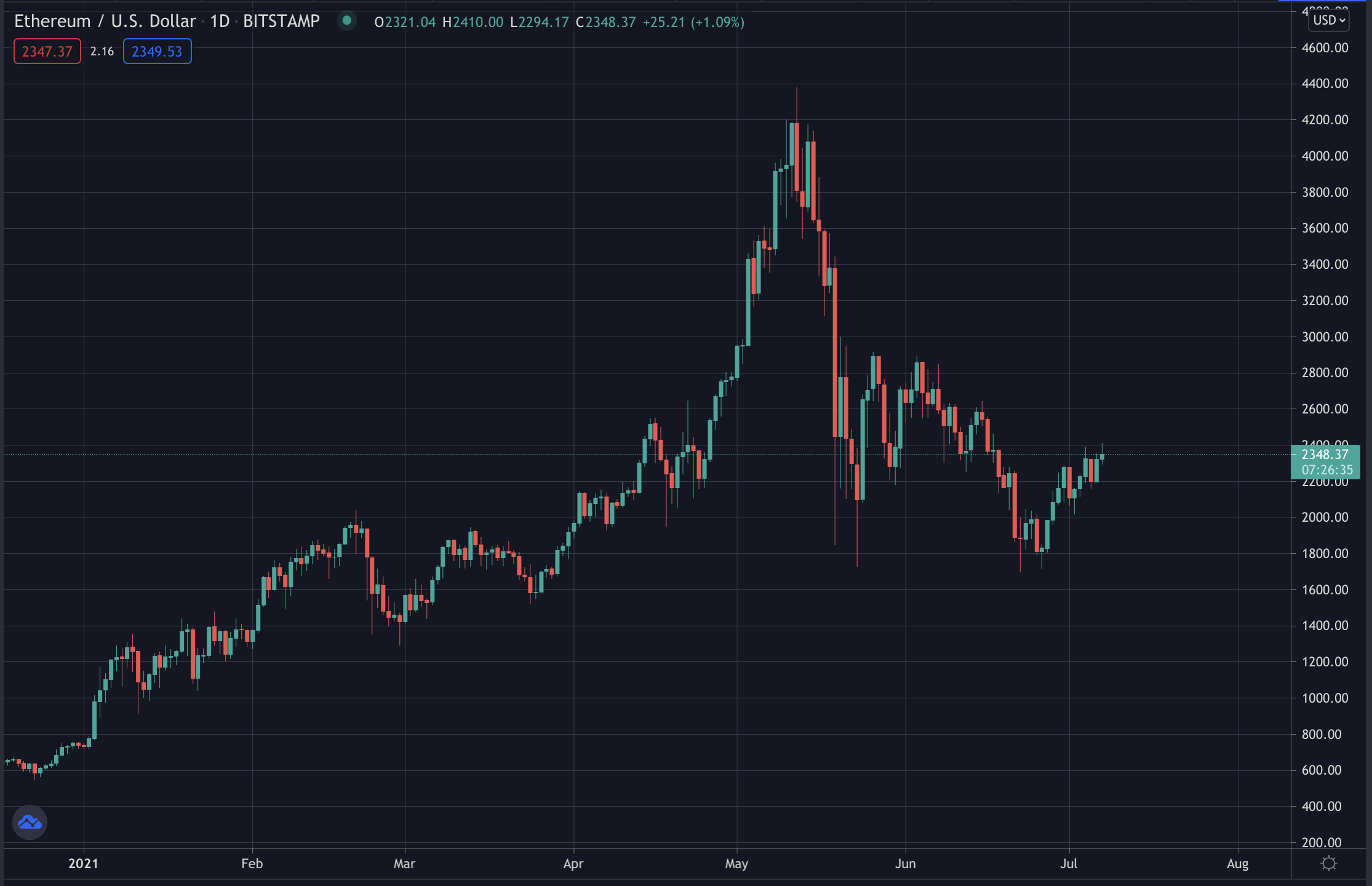After a December doubling the new year opens with a halvening of sorts from $1,100 to $750. A slow winter nonetheless sends the crypto to $1,300 in March, but a drop to $890 follows before the month ends.
The bear had beaten the bulls for years, but this time the bulls roar on a run to $3,000 in June. However, bears have a last laugh during summer swimming, sending it down to $1,800 in the greatest bear parade of the year.
The year opened with a bull run to $1,300 from $500, but it quickly gave way to a brief plunge to $900 in mid January.
Bulls charge and send it to $2,000 in February, but by the end of the month the crypto would fall to $1,270.
After years of bear, they keep dominance, until bulls finally charge in April sending the price to $4,400 by mid May.
However, bears have a last laugh during summer swimming, sending it down to $1,700 in the greatest bear parade of the year, marching to declare the end of bull.


The reflection is not perfect and obviously it’s not complete because we don’t know what happens next, but the similarity is so striking that one has to wonder whether there is something fundamental to it.
That’s especially when one considers current ethereum has the same inflation rate in new supply as bitcoin in 2017, and eth in 2017 had bitcoin’s 2013 rate.
This fundamental change in supply is presumably the main catalyst, but it is weak on its own where sentiment is concerned because it relies on the requirement for demand to at least remain the same for there to be gains.
Almost a year after the halvening, that there was one is now a distant memory, and for many newcomers it might not even be a known fact.
The evil bear however is still a pretty raw memory and a very scary one. For those that went through it, but here also for those that didn’t because through the many years they know just how bad the bitcoin bear can be.
So we get the end of bull bitcoin bear parade. Quite interestingly, it is precisely what we got exactly four years ago as well, with the then dominant question being Has Ethereum Entered a Bear Market?:
“Following ethereum’s price fall to $250 from a brief high of $420, many are wondering whether the market has turned with the bull giving way to the bear, at least temporarily. That’s what traders are speculating on today.”
We do prefer much more Ethereum Traders Complain Bear Whales Took Their Lambos. That was after a Gdax flash crash to 13 cent with the sentiment in June 2017 so turning to bull gone, now bears roam.
“After ethereum’s price plunged yesterday to a low of $206, halving from an all time high of $420, complaints started everywhere about bear whales taking everyone’s lambos.”
Too cute. We obviously know what happened next. That $200 was 8-xed, but not before the easy peze meme boy gained fame for insisting throughout that 8x bull run that ethereum will fall to $324.
It did, after mooning properly and not after the bears declared the bull is over. And yet why just a few months made such a huge difference is a curious matter.
As we now know in December-January 2017-18, Vitalik Buterin, Charlie Lee and other huge crypto holders sold their crypto and publicly, with ICOs then constantly dumping well into 2019.
Combined with a 20x price rise from the previous all time high, demand could not keep with new supply, and thus any effects of the halvening were part of history.
They decided to sell because the general feeling was that the price had reached a level it did not ‘deserve,’ with this subjective incredulity a hallmark of cryptos so far that continue to attract what some call a bitcoin deranged syndrome.
The crypto space is just too advanced, and its code based ‘teachings’ as well as ‘revelations’ too factual for some who benefit from manual systems to not outright despise it, and for the general populace ingrained in those systems to not be very skeptical as well as perplexed by it.
With our suggestion being that $20,000 was not a price bitcoin did not deserve, and now four years later that is somewhat clear. The bear instead was caused by artificial new supply based on sentimental judgment that considered a very simplistic was and is, instead of why it was and why it is.
Demand did not remain the same. Demand has grown by probably more than 10x even since 2017. Since there are far more people wanting crypto, naturally the price will reflect, with exchanges like Coinbase and others unable to keep up verifying new customers in late 2017.
This massive expansion can easily be missed by just looking at what the price was and what it is, or by engaging in esoteric technical analysis, something that may have led to artificial volatility in between because if there wasn’t a sell off by ICOs, then obviously there wouldn’t have been as deep a bear as it became in 2018-19, if there would have been one at all.
But what is interesting is that cryptos have been able to combat this incredulity or artificial new supply through a baseline of demand keeping a floor price which must translate to gains after halvening because that baseline remains the same, but new supply falls and thus price rises, something that in 2012 translated to bitcoin is not dead.
An awareness of this dynamic you’d think should remove the artificial incredulity element, with that baseline having much room to grow especially now with the addition of alternative financial services in defi, but such sophistication still has to deal with the more cheating element of just manipulating sentiment.
Not least because if cryptos do 10x now, everyone will say wow and that’s it for the bull, but if they reach that same 10x level in four years, everyone will say meh and speculate it will 10x further, with the bear now dead.
This so brings us to what may be the ultimate truth. Hodl is not a meme. It’s an idea. It states that there are elements which manipulate you emotionally to sell them coins in the promise you can buy them cheaper, but the manipulator wants those cheaper coins for themselves, and since you are foolish enough to fall to his tactics and he is smart enough to make you fall to them, that means he will be the one getting your coins for cheap and will leave you with none.
The fixed supply means you have to sell for someone else to get your coins. If you don’t, they have to put the price at a level you sell. The one buying it may well be smart enough to know this much, and they may well want 25% of the supply.
The trick that was played on our fathers will necessarily be played on us too because if you control the supply of actual money like gold, then you control money.
Our grandfathers were not fools however, so a law had to be enacted to forcefully confiscate their gold to give it to banks. China is not quite trialling this, but something similar when it comes to bitcoin.
The difficulty they have is that we can play the game too with more than 10,000 cryptos listed now, but Brave New World does work a lot more than 1984, and so the enticement of leverage or sell to buy back can end up achieving the same result.
If you hodl instead, you become part of that baseline, and since demand remains at least the same, you may well inevitably see gains within four years, with what you are holding being not an investment, but an unmanipulatable unit of measurement that reflect total productivity and value gains in the same way a ruler precisely reflects the size of a table.
In this system, there is no bear and there is no bear market as long as global productivity increases and even then, considering bitcoin is still a very fringe thing, until all those that have the desire to utilize it, have the opportunity to do so.
Under this perspective, price does not matter and the bull bear dance is just a game where we watch the party or slaughter of newbie retail.
What does matter is hodl as an initiation in a new code based global ‘army’ that braces entropy and its many forces to give birth to new energy which turns subjective money into an objective measurer of value.
Because we can do many things better than our grandfathers as we have code when they didn’t, and thus we can re-imagine the world and all its systems.
Source: https://www.trustnodes.com/2021/07/07/the-crypto-summer-an-echo-of-2017
- 000
- 100
- 2019
- AI
- All
- analysis
- April
- Banks
- Baseline
- Bear Market
- Bears
- Bitcoin
- brave
- Bull Run
- Bulls
- Buterin
- buy
- Buying
- call
- caused
- change
- charge
- Charlie Lee
- China
- code
- coinbase
- Coins
- complaints
- considers
- content
- continue
- Crash
- crypto
- Current
- Customers
- dead
- deal
- DeFi
- Demand
- DID
- Drop
- echo
- ends
- energy
- ETH
- ethereum
- Exchanges
- expansion
- Finally
- financial
- financial services
- Flash
- game
- General
- Giving
- Global
- Gold
- Grow
- halvening
- Halving
- here
- High
- history
- HODL
- How
- HTTPS
- huge
- ICOs
- idea
- inflation
- investment
- IT
- keeping
- Law
- Led
- Level
- Leverage
- Long
- March
- Market
- meme
- money
- months
- new year
- opens
- Opportunity
- Other
- People
- perspective
- price
- productivity
- Raw
- retail
- Run
- sell
- sentiment
- Services
- Size
- smart
- So
- sold
- Space
- started
- States
- summer
- supply
- system
- Systems
- tactics
- Technical
- Technical Analysis
- time
- Traders
- us
- value
- vitalik
- vitalik buterin
- Volatility
- Watch
- What is
- WHO
- within
- Work
- world
- year
- years













